
MAY CONTAIN NUTS

Search Shorpy
SHORPY ART

Framed or unframed, desk size to sofa size, printed by us in Arizona and Alabama since 2007. Explore now.
Join and Share
Ad-Free Shorpy
Shorpy is funded by you. Patreon contributors get an ad-free experience.
Learn more.

Recent comments
- Party of Eight?
- Good choice
- Recent view
- Hudson’s Big Store
- Say what??
- Grapes?!
- Just a Great photograph.
- A Beautiful Moment
- Such joy
- Bethune-Cookman University today
- Yellow sky at morning
- Side Winder
- Air Quality?
- Sojourner Truth riot
- None were so blind(ed)
- The less famous sister
- Good ol' days?
- Rise and Fall
- Goo Goo Ga Joob
- Ticket Retention
- Not the only one
- Vagaries of War
- Killed by Amtrak
- Back to the Future
- Wanted --
- If you can't stand the light
- Centralized Traffic Control, I believe
- What's really happening
- Heckuva remote control!
- Sometimes — Things Go Bump!
Member Photos
The Shorpy
Print Emporium
Print Emporium
Search Shorpy
Search results -- 30 results per page
- A Turn for the Worse: 1921
- ... upholstery tack strip is on the outside of the body (pre 1922). I think light color on the radiator is not brass, but a reflection off ... Posted by Dave - 09/09/2011 - 2:53pm -
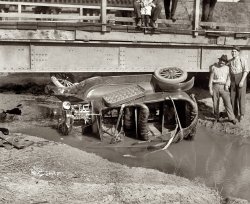
- Hell Gate: 1930s
- ... behind the darker building behind a stack (which is the 1922 Julia Richman High School, still there).
So where's the Opera ... Posted by Dave - 09/25/2013 - 2:16pm -
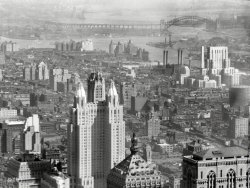
- Heavy Lifting: 1910
- ... sold the vessel to Cleveland's Pringle Barge Line in 1922, which had it converted to a self-unloading barge five years later using a ... Posted by Dave - 08/01/2014 - 9:05am -
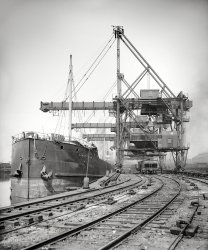
- Your Move: 1941
- ... which remained in revenue service until 2009, and I use a 1922 I-14 to track the energy consumption of the air conditioner in my utility ... Posted by Dave - 09/22/2019 - 1:11pm -
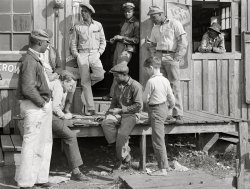
- James Beard: 1905
- ... its boiler exploded at dockside in Port Huron on March 22, 1922. Four crew members lost their lives and more than a half dozen people on ... Posted by Dave - 10/13/2012 - 7:56am -
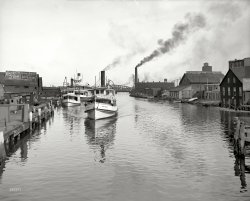
- The Colonial: 1901
- ... site of Fort Nassau, the hotel was destroyed by fire in 1922. Its current incarnation is the British Colonial Hilton Nassau, owned by ... Posted by Dave - 09/07/2021 - 9:11am -
![The Colonial: 1901 Circa 1901. "In the gardens -- Colonial Hotel, Nassau, Bahamas." Built by Henry M. Flagler on the site of Fort Nassau, the hotel was destroyed by fire in 1922. Its current incarnation is the British Colonial Hilton Nassau, owned by the China State Construction Engineering Corporation. 5x7 inch glass negative, Detroit Photographic Company. View full size.
The Burn File It's been far too long since our last entry in the Hotels Which Burned To the Ground series. Beauties, every one of them, and this is certainly a worthy addition.
What has captured the gardener's attention, I wonder. He's just to the right of the "Bicycles" sign.
Does anyone know the name of the wheeled chair behind the three men, just in front of the stairs? It looks as if it might be the kind which could be guided by its occupant, using a center control bar.
[Not quite. - Dave]
Rabbit hole alertOne of the owners of the follow-on hotel, the British Colonial Hilton Nassau, was Harry Oakes. If you have an hour or four, search out his story. He was a gold miner turned tycoon that owned a big chunk of the Bahamas. He was also murdered in Nassau in 1943, and the murder has never been solved.
(The Gallery, Bicycles, DPC)](https://www.shorpy.com/files/images/SHORPY-4a27469a.thumbnail.jpg)
- Fire: 1926
- ...
The Washington, D.C. Fire Department also had a 1922 American LaFrance Model 31 with a 75-foot spring-raised water tower (water ... Posted by Dave - 09/04/2012 - 2:46pm -
![Fire: 1926 Washington, D.C. "Fire at Thomas Somerville plant, July 20, 1926." 312 13th Street N.W. National Photo Company Collection glass negative. View full size.
GoneIt looks like the entire block was razed a long time ago, and the Ronald Reagan Building and International Trade Center stands on the site now.
ApparatusI may be wrong (I often am), but would guess the fire apparatus at right was probably once a horse-drawn ladder wagon, and a motor tractor was added in place of the "old" horse power.
A hot time in the old houseNo. 312 Thirteenth Street had a colorful history. Washington Post article of Dec. 16, 1895 gives a glimpse into the neighborhood's earlier character.
Three Disorderly Houses Raided.
There were lively times in the "Division" last night. About 10 o’clock Officers Flathers and Kilmartin took a girl, who said her name was May Martin, out of the house of Lizzie Peterson, 1309 D street. At the First precinct station house the girl was charged with being under age. She claims that she is twenty-two years old.
An hour later the house of Alice Linden, 312 Thirteenth street, was raided by Sergt. Shilling and a squad of officers. Mrs. Linden and six women were captured. They were taken to No. 1 station house and charged with keeping a house of ill repute.
[Since "The Division" was in Northwest, this would seem to be the same address, as opposed to 312 13th Street Southeast, Southwest or Northeast. - Dave]
"The Division" explainedDuring the Civil War, General Hooker's command was stationed in Washington, DC. The rowdy troops gave so much business to the local houses of ill repute that the entire red-light district was nicknamed "Hooker's Division" and hence led to the later practice of a prostitute being referred to as a "hooker."
[I think that's been pretty much debunked as legend. Prostitutes were called hookers well before the Civil War. - Dave]
American LaFranceThe fire truck is an American LaFrance Type 31 circa 1916. This model was made all the way through 1929 without many changes. This is D.C. Truck No. 1 as shown on the raised ladder.
What is really interesting about these models is that the driver's seat swivels with the ladder. Look behind where the fireman is standing on the truck and you see the driver's seat facing backwards. Note also the dual front tires found on the earlier of these models.
The Washington, D.C. Fire Department also had a 1922 American LaFrance Model 31 with a 75-foot spring-raised water tower (water cannon/snorkel). This was Water Tower No. 2. It served the city for more than 30 years.
I hope the water pressure doesn't change and cause the hose on the sidewalk to topple the ladder on the sidewalk.
(The Gallery, D.C., Fires, Floods etc., Natl Photo)](https://www.shorpy.com/files/images/16076u.thumbnail.jpg)
- Our Man in Washington: 1921
- ... Motion Picture Producers and Distrbutors Association in 1922. However he really didn't have a code to enforce at that time, just his ... Posted by Dave - 08/09/2012 - 11:42am -
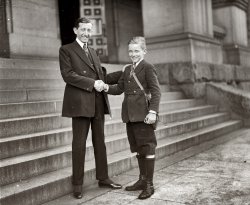
- We Ate the Chickens: 1939
- ... got better after this.
The Depression. My dad, born 1922, used to tell us kids about the poor family that lived in a palmetto shack ... Posted by Dave - 03/27/2018 - 12:13am -
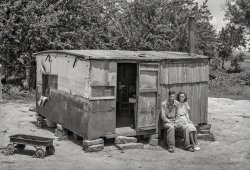
- Civil Servant: 1942
- ... numerals indicate this one was manufactured in 1921 or 1922. Reproductions have been made in more recent years. See this .
Nice ... Posted by Dave - 01/31/2013 - 4:36am -
![Civil Servant: 1942 August 1942. "Ella Watson, government charwoman who provides for a family of six on her salary of $1,080 per year. She has been a federal employee for 26 years." Label on the wastebasket: "Miss Engle, Div of Recounts." Large format negative by Gordon Parks, Office of War Information. View full size.
The clockThe clock is a Seth Thomas Regulator No. 2, first introduced in the 1860s and produced through 1950, with changes in mechanism, case and dial made over time. The style of the base and the use of Arabic numerals indicate this one was manufactured in 1921 or 1922. Reproductions have been made in more recent years. See this.
Nice catchNice catch mountainrev, nice response tterrace, nice community Shorpy.
Challenging ClockWinding that clock would be challenging. Not only is it mounted 7 feet high, it's behind file cabinets. Wonder how they did it.
[You don't wind pendulum clocks. - tterrace]
Could you clarify that statement please, tterrace?
[Yes; I was wrong. - t(blush)terrace.]
Pendulums simply regulate clocks. They don't have anything to do with what drives them. This clock has what appears to be a weight in addition to the pendulum. Grandfather clocks typically are driven by weights, which need to be raised periodically. If this clock was driven by a weight, then you're right--it wouldn't need to be wound. But someone would still have to raise the weight regularly, which would be as challenging as winding it, or nearly so. And given the relatively short distance the weight would drop (compared to a grandfather clock), I would imagine it would have to be raised daily or every other day.
Lighting the wayIt appears Mr. Parks used a slave flash behind the pile of trash cans on the right, judging from what may be part of a reflector showing. If so, it either didn't fire or was of less intensity than the one bottom left, used to side light the subject's face. He probably wanted to keep the clock visible. Is that a Seth Thomas clock?
Not quick enoughHaving lurked here for several years, I finally had to register to catch tterrace in an error. As a clock repairman for over 40 years, I know you DO have to wind a weight-driven clock. Sometimes by simply pulling the chain down on the opposite side of the weight pulley. This clock, however, has a crank-shaped key that is inserted in the small hole (about the 4-o'clock position near the second hand circle) and turned to wind the weight cable onto a ratcheted drum, pulling the weight up. It may have been and 8-day clock, but I agree it was probably a daily chore.
(The Gallery, D.C., Gordon Parks)](https://www.shorpy.com/files/images/SHORPY_8b37537u.thumbnail.jpg)
- Peace and Progress: 1924
- ... still exist today.
A photograph of a later model from 1922 is shown below.
(The Gallery, Natl Photo, Politics) ... Posted by Dave - 09/09/2008 - 3:47pm -
![Peace and Progress: 1924 September 29, 1924. "Mrs. LaFollette at Mountain Lake Park, Maryland." National Photo Company Collection glass negative. View full size.
The carWhat kind of car is that? Two air intakes in the cowl?
UFO?I'm in love with the kid under the "Peace" sign with the enormous white collar with his tongue sticking out. Is he also wearing glasses? A possible candidate for a Shorpy zoom perhaps?
Can Shorpy readers help me identify the unidentified flying "steering wheel"-looking thing above the flowers on the right-hand car? It seems too high to be a steering wheel and it doesn't appear to be a part of a musical instrument. It looks like it's about to hit that woman in the head.
[It's the steering wheel of a car. - Dave]
ArmoredThat almost looks like an armored car. That huge visor is reminding me of the metal plates they could swing down across a halftrack windshield. And those intakes look like snorkels on a Land Rover or APC. But it's probably just oddly designed to look that way, 9x13 cake pans and all. And criminy, long men's coats and knickers were not two things one should wear at the same time. In fact, knickers should never be worn.
McFarlan Motor CarThe car pictured is undoubtably a circa 1920 McFarlan. These were produced in very low numbers in Connersville, Indiana from 1910 - 1928.
Several engines were available including a "Light 6" on a 127" wheelbase, a straight 8 with a 131" wheelbase, and a "Twin Six" with four valves per cylinder along with three spark plugs per cylinder on a 140" wheelbase.
These cars were massive often exceeding 3 tons in weight. With production often less than 100 per year it is amazing that about 20 still exist today.
A photograph of a later model from 1922 is shown below.
(The Gallery, Natl Photo, Politics)](https://www.shorpy.com/files/images/12161u.thumbnail.jpg)
- Public Square Panorama: 1908
- ... 1907, and changed their name to the Union Gospel Press in 1922. They are still publishing; they specialize in Sunday School lessons.
... Posted by Dave - 04/09/2019 - 6:26pm -
![Public Square Panorama: 1908 Cleveland circa 1908. "The Public Square -- Soldiers' and Sailors' Monument. Panorama made from two 8x10 inch glass negatives. View full size.
Different timesWhere are all the Zombies with their smartphones?
GWS SocietyThe GWS Mission (lower right) is run by the Gospel Worker Society. The society published nondenominational fundamental Christian literature, and set up missions in "gospel-neglected towns". They moved their headquarters to Cleveland in 1907, and changed their name to the Union Gospel Press in 1922. They are still publishing; they specialize in Sunday School lessons.
City FlagThe lower flag on the pole just left of center is the Cleveland City Flag, adopted in 1896.
Jam packedWhat is going on in that second block up on the right? The sidewalk is crammed with people! Am I seeing this correctly?
[You'll come for the Kodaks, but stay for the $2 Hats. - Dave]
(Panoramas, Cleveland, Stores & Markets, Streetcars)](https://www.shorpy.com/files/images/SHORPY-Cleveland_Public_Square_Panorama_2.thumbnail.jpg)
- Featured Player: 1920
- ... An article in the Deaf-Mutes' Journal, from March 30, 1922, states he was the Athletic Coach for the ASD. In a 1951 Inter-Class ... Posted by Dave - 11/17/2016 - 8:36pm -
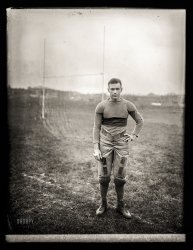
- Spaghetti Girls: 1921
- Washington, D.C., 1921 or 1922. "Food show. Foulds Milling." The Foulds slogan: "Appetizingly Clean." ... Posted by Dave - 09/03/2012 - 11:54am -
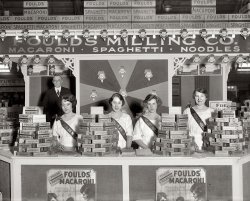
- Dawsonville: 1917
- ... of White's Ferry and Sugarland Roads. It burned in 1922, five years after the date of this photo. What is odd about the site today ... Posted by Dave - 06/21/2015 - 1:28pm -
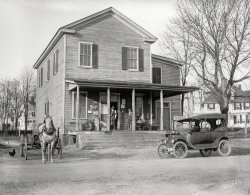
- Nebraska: 1938
- ... the tall smokestack, sits Johnny's Cafe. Established in 1922 and still serving today, it remains as one of the last artifacts of the ... Posted by Dave - 09/14/2017 - 6:28am -
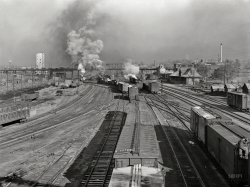
- Moldy Manse: 1937
- ... "The Brother of the Sultan," in Legends of Louisiana (1922).
The curious date palm has it's own romantic legend, but that's ... Posted by Dave - 11/07/2013 - 2:24pm -
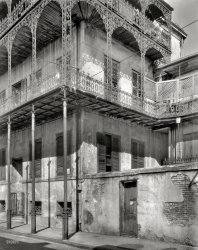
- Clack Elevator: 1941
- ... the oil business "Clack entered the Spokane market in 1922, setting up tanks, distribution and new stations. He watched as ... Posted by Dave - 10/11/2019 - 2:42pm -
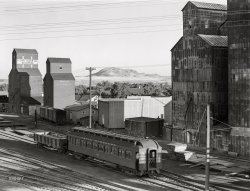
- On Time All the Time: 1921
- ... Limited An alternate view, and a newspaper ad from 1922. Click to embiggen:
Duplexia In addition to a ... Posted by Dave - 07/04/2019 - 9:17am -
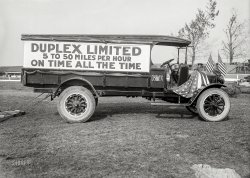
- Auburn Garage: 1928
- ... a "Mrs. Arthur D'Ettel" listed at 740 Hyde St. in the 1922 "Who's Who Among the Women of California"
There's an obituary for a ... Posted by Dave - 02/07/2017 - 6:39pm -
![Auburn Garage: 1928 Arthur D'Ettel of the California Automobile Trade Association.
San Francisco, 1928. "Auburn 115 at garage." Right across whatever building that is reflected in the fender. 5x7 glass negative by Christopher Helin. View full size.
Possible IDThis appears to be Arthur D'Ettel of the California Automobile Trade Association.
[Funny, I was just thinking, "That looks like Arthur D'Ettel"! - Dave]
Still laughingDave, I think that's the funniest comment I've come across in a long time!
[;-D - Dave]
Details on Mr. Arthur D'Ettel?Because the Auburn represents the era in automotive history before the US auto industry settled on The Big Four manufacturers, I'd be interested in what else the Shorpy Sleuths can uncover about this man.
There's a "Mrs. Arthur D'Ettel" listed at 740 Hyde St. in the 1922 "Who's Who Among the Women of California"
There's an obituary for a Mrs. Arthur D'Ettel, which states that her husband, Arthur Holland D'Ettel died in 1998.
So, was the Arthur Holland D'Ettel who passed away in 1998 the same gent who posed beside this spiffy Auburn in 1928?
Jackson at Van NessThe location is on the south side of Jackson between Polk & Van Ness. The building the car is emerging from was most recently Ahrens bakery; the building is very little altered since 1928 and the garage entrance is still there. The building in the reflection (2000 Van Ness) started out as a Packard showroom/dealership in 1909 but had grown from three floors to seven just a year or two before the pic was taken and had been converted into the "Medical Arts Building" - which it still is.
(The Gallery, Cars, Trucks, Buses, Chris Helin, San Francisco)](https://www.shorpy.com/files/images/SHORPY-1085_0.thumbnail.jpg)
- Lincoln Garage: 1925
- ... with great satisfaction to be sure, the Lincoln brand in 1922. We get a glimpse of the cars V8, the block of which was cast in two ... Posted by Dave - 09/05/2013 - 11:17am -
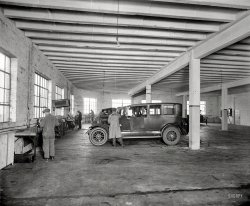
- Future Farmer: 1939
- ... farm in Hebei province.
James Bud Kimberley 1922-1993 December 25, 1922 to Feb. 3, 1993.
James Bud Kimberley of Collins, Iowa, died age 70 ... Posted by Dave - 12/24/2017 - 10:43am -
![Future Farmer: 1939 September 1939. "Bud Kimberley, a future farmer of America, driving a tractor. Jasper County, Iowa." The brother of Margaret, seen here yesterday. Photo by Arthur Rothstein for the Farm Security Administration. View full size.
No Comments Yet?Don't tell me I'm the first to comment about a young Paul Newman driving that tractor?
Keeping up with the KimberleysMargaret Lou's two brothers, James and Howard, outlasted World War II. Generations of the extended Kimberley family included owners of at least six farmsteads in northwestern Jasper County and southeastern Story County, small-town bankers, county and state agricultural agents, and many others. According to a 2016 Des Moines Register story, Kimberley Farms Co. now owns or rents over 4,000 acres in Jasper, Story and Polk Counties. One of its farms has been visited twice by Chinese President Xi Jinping, who announced plans to use it as the model for a demonstration farm in Hebei province.
James Bud Kimberley 1922-1993December 25, 1922 to Feb. 3, 1993.
James Bud Kimberley of Collins, Iowa, died age 70 of a heart attack at his home in rural Collins.
He was born to John B. and Carrie (Dunlap) Kimberley at Collins. He was a lifelong resident in the Collins area, graduating from Collins High School and attending Iowa State University for one year. He married Alta Harris on Nov. 21, 1942, at the Little Brown Church at Nashua. He was a self-employed as a farmer. He was a member of the Collins United Methodist Church and was a Mason.
Survivors include his wife, Alta, of Collins: his three daughters, Nancy Smith and Jean Nielsen, both of Chicago, and Kerry Funke of Norwalk; five grandchildren; and two sisters, Margaret Fisher of Twin Lakes and Blanche Bodie of Knoxville.
A-C WCThere isn't much shown of the tractor Bud is driving - so I had to do some digging.
It appears to be an Allis Chalmers WC series tractor. The stamped end of the fuel tank makes this an earlier model; later versions of the tractor had rounded tanks.
[Below, more of Bud and his tractor. - Dave]
(The Gallery, Agriculture, Arthur Rothstein)](https://www.shorpy.com/files/images/SHORPY-8b18317a.thumbnail.jpg)
- Ford Parts: 1920
- ... a Ford dealership, the Taylor-Tolley Sales Company.
By 1922, the company was called the R.L. Taylor Motor Company , and added the ... Posted by Dave - 03/12/2018 - 10:32am -
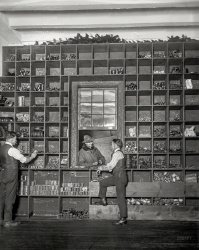
- Tecumseh: 1916
- ... refitted, and—sometime between July 1921 and January 1922—was placed back in commission at Washington where she served through the ... Posted by Dave - 08/28/2012 - 1:02pm -
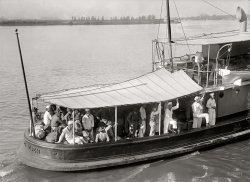
- Carl Bangs Jr. at Mt. Rainier
- My dad was born in 1922 so I'm guessing this one is around 1930. Can anyone tell from the ... older, teens to early 20's. But if your dad was born in 1922, it would have to be around 1930 or so.
(ShorpyBlog, Member Gallery) ... Posted by elisekasten - 05/09/2014 - 7:35pm -

- Ghost Rider: 1920
- ... to be 2000 Washington St. under construction, completed in 1922. Today you can get one of its full-floor condos for around $10 million.
... Posted by Dave - 09/02/2015 - 9:46pm -
![Ghost Rider: 1920 San Francisco circa 1920. "Buick, Pacific Heights." Wearing a spiffy "California top." 5x7 glass negative by Christopher Helin. View full size.
EnterHow did a person get into the car? The doors seem to go no higher than to the bottom of the windows. Unless the entrances are on the driver's side.
[This is an open-body car, with an after-market California top installed. The side windows are part of the top. -tterrace]
The Big HouseThat's the Spreckels Mansion again. Down the block, that appears to be 2000 Washington St. under construction, completed in 1922. Today you can get one of its full-floor condos for around $10 million.
They all look alikeSeems back in the early days it was equally difficult to tell car marques apart as it is today. Only during the 50's and 60's did cars appear to have their own character.
(The Gallery, Cars, Trucks, Buses, Chris Helin, San Francisco)](https://www.shorpy.com/files/images/SHORPY-634A.thumbnail.jpg)
- Stop Ahead: 1925
- ... ended production, after about 40,000 had been made from 1922 - 1926 (some sources mention production actually ended in January 1927), ... Posted by Dave - 06/29/2016 - 10:07pm -
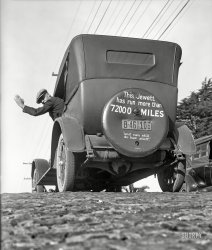
- One-Ring Circus: 1905
- ... of the Jungle" act with as many as 10 lions and tigers. A 1922 flyer for the Orpheum advertises his "Kings of the Forest and Desert" act ... Posted by Dave - 11/19/2014 - 11:03am -
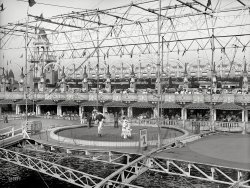
- At Anchor: 1919
- ... largest American car maker in 1917, went wheels-up in 1922.
San Francisco, 1919. "Saxon touring car at boatyard." Today's ... Posted by Dave - 07/31/2017 - 5:59pm -
![At Anchor: 1919 Saxon, the seventh largest American car maker in 1917, went wheels-up in 1922.
San Francisco, 1919. "Saxon touring car at boatyard." Today's entry on the Shorpy Roster of Musty Marques. 5x7 glass negative by Chris Helin. View full size.
Star Plated in 1919The encore of the car and gentlemen previously seen along the docks here. With the license plate now visible we know that the vehicle belonged to Mr. Charles E. O'Day of 1763 Geary Blvd., San Francisco. At the time the photo was taken he was a salesman at DuBroy Motor Company, Inc.
DuBroy Motors started out as the Saxon Sales Company circa 1916 at 690 Van Ness. President and general manger was Francis Louis DuBroy. By 1917 the company had moved to 1529 Van Ness Ave which was the southeast corner of Van Ness and California at the time. In addition to the Saxon the dealership was also selling Nash automobiles. By 1920 the firm had relocated again to 1290 Sutter with a service department at 1615 Pine. The old location on Van Ness became the Pacific Nash Motor Company so it appears that DuBroy either lost or sold his Nash distributorship.
Prior to working at DuBroy Motors Charles O'Day had worked as a chauffeur since at least 1909. He stayed on at Pacific Nash when DuBroy moved his business, and he later became the sales manager for the dealership. We know he left that firm around the year 1933 as he had become the sales manager for James W. McAlister Chrysler and Plymouth by sometime in either 1933 or 1934. He remained there into at least 1944. By 1945-1946 he was with George S. Daniels Pontiac Motor Sales which became Weltner Pontiac circa 1954. Weltner was located across the street from the former DuBroy dealership when it was on Van Ness with an address at 1560 Van Ness (with street renumbering still at California & Van Ness).
So, 25 years after O'Day started selling cars, he was right back where he began. He remained at Weltner into at least 1954, but he later sold cars at McAlister Buick from about 1955 - 1958 and Volkswagen cars for Reynold C. Johnson during the years 1959 - 1968. By 1971 he was retired, he died on September 2, 1982, and he was buried in Colma, California along with his wife Leona who died in 1976.
A feature in the UPI archives on the 75th anniversary of the 1906 San Francisco Earthquake included a story from O'Day. "Charles O'Day told of how his family lost their house but happened to have crates of dishes in the wreckage. In the following months, the dishes were sold piece by piece and produced $1,600 with which the family opened a restaurant."
Vanity License PlateThe 'STAR' embossed on the license plate indicates the men were law enforcement officers, detectives, etc.
[No, the star is a validation tab to indicate vehicle registration for the year 1919. -tterrace]
Getting in on the ground floor...as a Saxon dealer in the small town of Waldron, Arkansas, circa 1914.
(The Gallery, Boats & Bridges, Cars, Trucks, Buses, Chris Helin, San Francisco)](https://www.shorpy.com/files/images/SHORPY-1200.thumbnail.jpg)
- King of the Hill: 1908
- ... on east side of US Capitol? Or did it come later, say ~1922?
[You're on the wrong side. The Reflecting Pool faces the Capitol's ... Posted by Dave - 10/04/2013 - 11:35am -
![King of the Hill: 1908 Circa 1908. "North view of United States Capitol, Washington, D.C." 8x10 inch dry plate glass negative, Detroit Publishing Company. View full size.
Butler MansionThe blockish building beyond the steps to the House is the former Butler Mansion, previously seen at Public Health: 1914.
Large fountain on left center of photoThought there was a very large pond / fountain on east side of US Capitol? Or did it come later, say ~1922?
[You're on the wrong side. The Reflecting Pool faces the Capitol's West Front. - Dave]
Yes the Capitol Reflecting Pool came many years later & is on the West side of the Capitol, between 1st & 3rd Sts NW & SW. This pic was taken in NE facing south. Between the Capitol and 1st St NE & SE where 2 large parking areas were until the Visitor Center showed up a few years ago. Part of that parking area was the pool / "pond" / fountain that was paved over. 20's, 30's or maybe a little later. Maybe someone can find & post a pic. My Mom & her family lived at 216 Maryland Ave NE & her & her 2 brothers would go play around the "pool" - 1923 to 1925. Guess it's time to visit the Architect of the Capitol for his pictures.
RSOBThis was probably taken from the roof of the brand-new Senate Office Building (later the Old SOB after the New SOB was built in the 1950s, now the Russell SOB since the Hart SOB was built in the 1970s.) I worked in it for 10 years, at the Armed Services Committee chambers, right off the rotunda.
(The Gallery, D.C., DPC, Streetcars)](https://www.shorpy.com/files/images/SHORPY_4a20001a.thumbnail.jpg)























